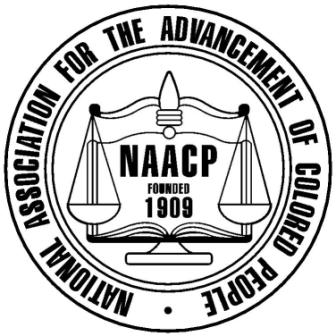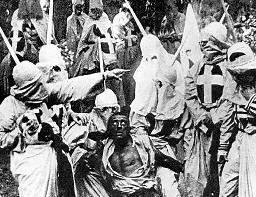|

NAACP Logo
|
NAACP Facts and History Timeline for kids: Fast Fact Sheet
Fast, fun facts and Frequently Asked Questions (FAQ's)
about the NAACP Facts.
What does NAACP stand for? The NAACP
stands for National Association for the
Advancement of Colored People.
Who founded the NAACP? The NAACP was
founded by a group of white progressives and
liberals that included Mary White Ovington
and Oswald Garrison Villard and African
American civil rights activists including W.
E. B. Du Bois, Ida B. Wells-Barnett and Mary
Church Terrell
What was the reason for the founding of
the NAACP?
The NAACP was founded in response to
racial discrimination and violence against
African Americans including the practice of
lynching and the 1908 race riot in
Springfield, Illinois
What did the NAACP do?:
The NAACP fought for civil rights, the
elimination of racial discrimination,
desegregation, fair voter registration and
the advancement of African Americans through
lobbying, legal action, and education..
NAACP Facts and History Timeline for kids: The Progressive Era and the
Niagara Movement
The NAACP was sparked
by the spirit of the
Progressive Movement that tackled many
social problems, passed laws, amendments and reforms
to protect workers and regulate big business during the presidencies
of Roosevelt, Taft and Wilson. However there were limits to
Progressivism which failed to address African American reform
issues. In 1905 twenty-eight Prominent African American leaders and
civil rights activists, led by W.E.B. Du Bois, formed the
Niagara
Movement. Members and supporters of the Niagara Movement formed the
NAACP four years later in 1909.
NAACP Facts and History Timeline for kids
The NAACP
facts and history timeline
details important people and political events in
the NAACP Facts and History Timeline. Interesting facts via the
NAACP Facts and History Timeline are detailed below. The information
via the NAACP Facts and History Timeline is told in a
factual, date sequence consisting of a series of
short facts providing a simple method of relating
the history and events in the fight for civil rights.
NAACP Facts and History
Timeline for kids
NAACP Facts
Timeline 1895: Booker T. Washington delivers a
speech calling for a moderate approach to race
relations. W.E.B. Du Bois attacked Booker T.
Washington’s Atlanta Compromise speech accusing him of
abandoning the fight for black political rights and
accepting segregation in exchange for deceptive economic
gains..
NAACP Facts
Timeline 1896: In 1896 the Supreme Court decided in
Plessy vs. Ferguson that "separate but equal"
facilities satisfied the guarantees of 14th Amendment,
thus giving legal sanction to
Jim
Crow Segregation Laws
NAACP Facts
Timeline 1905: W.E.B. Du Bois, formed the
Niagara
Movement in 1905
NAACP Facts
Timeline 1908: The Springfield, Illinois race riot
of 1908 took place on August 14 and 15, 1908
NAACP Facts
Timeline 1909: The National Association for the
Advancement of Colored People (NAACP) was founded by
Mary White Ovington, Oswald Garrison Villard, W. E. B.
Du Bois, Ida B. Wells-Barnett and Mary Church Terrell
NAACP Facts
Timeline 1910: The National Negro Conference was
held on May 31 - June 1, 1910 in New York City. W.E.B
DuBois is selected as the director of publications and
research.
NAACP Facts
Timeline 1910: The Crisis, the official magazine of
the National Association for the Advancement of Colored
People was founded in 1910 by W. E. B. Du Bois (editor)
NAACP Facts
Timeline 1913:
in 1913 the federal government, under President Wilson,
imposed racial segregation in government offices in
Washington, D.C.
NAACP Facts
Timeline 1915: The NAACP organization learned to harness
the power of publicity through its 1915 battle against
D. W. Griffith's inflammatory movie 'Birth of a Nation'.
'Birth of a Nation' perpetuated demeaning stereotypes of African
Americans and glorified the Ku Klux Klan.
Many NAACP members
protested at the premieres of the movie in numerous
American cities and riots broke out in Boston and
Philadelphia.

NAACP Facts
Timeline 1915: Guinn v. United States (1915). The
Supreme Court struck down grandfather clauses in state
constitutions as unconstitutional barriers to voting
rights granted under the 15th Amendment
NAACP Facts
Timeline 1916: The NAACP established an
anti-lynching committee.
NAACP Facts
Timeline 1917: Buchanan v. Warley (1917). The
Supreme Court barred municipal ordinances requiring
racial segregation in housing
NAACP Facts
Timeline 1917: During WW1 the newly-formed NAACP led
the fight against discrimination and segregation and to
prevent mistreatment of African Americans in the
military.
NAACP Facts
Timeline 1917: The East St. Louis riot (May and July
1917) was an outbreak of labor and race-related violence
in the city of East St. Louis, Illinois
NAACP Facts
Timeline 1917: The NAACP organizes the Silent
Protest March in New York, N.Y. attended by 8,000 -
10,000 African Americans on July 28, 1917.
NAACP Facts
Timeline 1918: The Assistant Field Secretary of the
NAACP, Walter White, travels into the south IN 1918 and
reports on
lynching and other violence against African Americans,
including the lynching of 15 year old Sammie Smith in
Nashville, Tennessee.
NAACP Facts
Timeline 1918: The NAACP released the booklet
"Thirty Years of Lynching in the United States,
1889-1918" and begins to fly a flag from its office with
the words, “A Man Was Lynched Yesterday”.
NAACP Facts
Timeline 1919: Harlem, New York had the highest
concentration of black people in the world, and was the
cultural heart of African-Americans with many NAACP
members. The whole of the all-black 369th Infantry
regiment called the
Harlem
Hellfighters received the French Croix de Guerre.
NAACP Facts
Timeline 1920: The NAACP appointed James Weldon
Johnson as its first African American executive
director. James Weldon Johnson was a
Harlem
Renaissance writer and, with his brother, had written
the song "Lift Every Voice and Sing."
NAACP Facts
Timeline 1923: The Supreme Court ruled in
Moore v. Dempsey (1923) that exclusion of African
Americans from a jury was inconsistent with the right to
a fair trial.
Continued...
NAACP Facts and History
Timeline for kids
NAACP Facts and History Timeline
Details of important people and interesting
historical events continue in the NAACP facts and
history timeline for kids.
NAACP Facts and History
Timeline for kids
NAACP
Timeline 1920's/1930's: The NAACP provided legal, financial,
and moral support in the
Great Depression of the 1920's
and 1930s
NAACP Facts
Timeline 1939: Marian Anderson is denied permission
to sing at the Daughters of the American Revolution’s
(DAR) Constitution Hall. Eleanor Roosevelt resigns from
the DAR in protest and helps arrange the concert on the
steps of the Lincoln Memorial. Marian Anderson sang at
the Lincoln Memorial at the request of the First Lady
NAACP Facts
Timeline 1940: The NAACP created separate legal arm
in 1940 called the NAACP Legal Defense and Educational
Fund. Thurgood Marshall was appointed as its
director-counsel
NAACP Facts
Timeline 1941: During World War II the NAACP renewed
efforts to end discrimination in the military. The Air
Force began training black pilots in 1941 at a
segregated base at Tuskegee Institute.
NAACP Facts
Timeline 1941: Support is given to A. Philip
Randolph’s proposed mass
March on Washington to protest
discrimination in defense industries and armed forces.
NAACP Facts
Timeline 1941: The first segregated airman unit, the
99th Squadron, famously known as the
Tuskegee Airmen,
was established in 1941
NAACP Facts
Timeline 1942: In 1942 the Navy and Marines agreed
to enlist blacks for general service
NAACP Facts
Timeline 1945: In 1945 the NAACP sent Walter White
and W. E. B. Du Bois to the United Nations Conference on
International Organization to propose the abolition of
the colonial system.
NAACP Facts
Timeline 1947: W. E. B. Du Bois reinforced the
NAACP’s by submitting to the United Nations “An
Appeal to the World,” a petition linking the history of
racism in America to the treatment of people of color
under colonial imperialism.
NAACP Facts
Timeline 1948: President Truman abolished racial
segregation in armed services in 1948 by executive order
NAACP Facts
Timeline 1950: The Supreme Court ruled in Sweatt v.
Painter 1950 that racially segregated professional
schools inherently unequal and therefore
unconstitutional
NAACP Facts
Timeline 1950: The first integrated combat units saw
action in Korea
NAACP Facts
Timeline 1954:
Brown v. Board of Education of
Topeka, Kansas ruled racial segregation in public
schools unconstitutional
NAACP Facts
Timeline 1955: Member Rosa Parks was arrested and
fined for refusing to give up her seat on a segregated
bus in Montgomery, Alabama
NAACP Facts
Timeline 1955:
Martin Luther King became involved in
protests against the incident involving Rosa Parks and the
Montgomery Bus Boycott
began.
NAACP Facts
Timeline 1957: The president of the Arkansas State
Conference of NAACP Branches, Daisy Bates, leads the
fight to
desegregate Arkansas schools.
NAACP Facts
Timeline 1957: In September, 1957 the Central High
School in Little Rock, Arkansas, is integrated.
NAACP Facts
Timeline 1964: NAACP political lobbying led to
passage of the 1964 Civil Rights Act.
NAACP Facts
Timeline 1965: NAACP political lobbying led to
passage of the 1965 Voting Rights Act
NAACP Facts
Timeline 1967: Thurgood Marshall was appointed as
the first African American associate justice of the
Supreme Court.
NAACP Facts
Timeline 1968: NAACP lobbying led to passing of the
1968 Fair Housing Act
NAACP Facts
Timeline 1974: Milliken v. Bradley saw the Supreme
Court overturned efforts to integrate white suburban
school districts with black urban districts.
NAACP Facts
Timeline 1992: The 1992 Los Angeles riots.
NAACP Facts
Timeline 1978: Regents of University of California
v. Bakke 1978 in which the Supreme Court placed limits
on affirmative action programs
NAACP Facts
Timeline 1989: The 1989 Silent March protesting
against U.S. Supreme Court decisions reversing many of
the gains
made against discrimination.
NAACP Facts
Timeline 1997: NAACP launched the Economic
Reciprocity Program initiating the "Stop The
Violence, Start the Love' campaign.
NAACP Facts
Timeline 2001: The 2001 Cincinnati riots. NAACP
develops a five year strategic plan.
NAACP Facts
Timeline 2001: The NAACP joins a class action
lawsuit against the state of Florida in 2001 alleging
voter irregularities in the 2000 presidential election.
NAACP Facts
Timeline 2001: In 2010 Barack Obama was elected the
44th President of the United States and for the first
time, an African American was elected to the most
important position in the land
NAACP Facts and History
Timeline for kids
For visitors interested in the history of African
Americans refer to the following articles:
Black
History for kids: Important People and Events
For visitors interested in African American History
refer to
Black
History - People and Events.
A useful resource for
teachers, kids, schools and colleges undertaking
projects for the Black History Month.
NAACP Facts for kids - President Theodore Roosevelt
Video
The article on the NAACP Facts provides detailed facts and a summary of one of the important events during his presidential term in office.
The following video will give you additional
important facts and dates about the political events
experienced by the 26th American President whose
presidency spanned from September 14, 1901 to March
4, 1909.
NAACP Facts
●
Interesting Facts about NAACP Facts for kids and schools
●
Key events
and NAACP Facts for kids
●
The NAACP Facts, a major
event in US history
●
Theodore Roosevelt Presidency
●
Fast, fun facts about the NAACP Facts
●
Foreign & Domestic
policies of President Theodore
Roosevelt
● Theodore Roosevelt Presidency and
NAACP Facts for schools,
homework, kids and children |